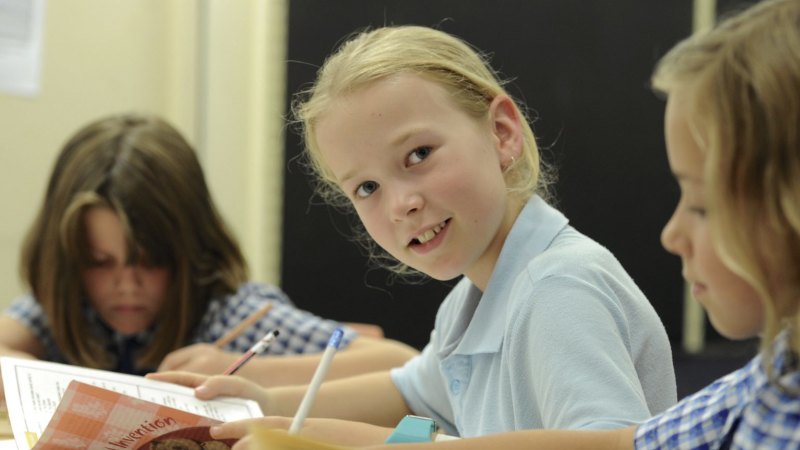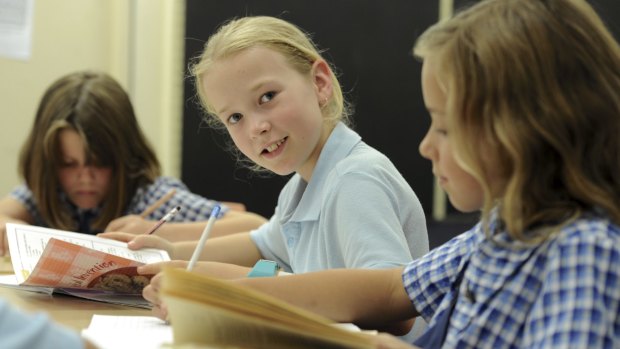Save articles for later
Add articles to your saved list and come back to them any time.
It is puzzling to read that, according to the 2023 NAPLAN results, 28.9 per cent of Victorian school children are struggling to meet literacy and numeracy proficiencies, and that 39.5 per cent of Year 9 students perform below proficiency in writing, but that the education minister considers these to be “phenomenal NAPLAN results”.
Calling the results “a clear indicator we are delivering nation-leading education to a generation of Victorian students in the Education State,” makes me wonder how the parents of the more than one in four Victorian students who cannot read proficiently feel.
The OECD used to hold Australia as one of the best in class in education.Credit: Graham Tidy
School illiteracy is no fault of children or their parents. Nor is it any fault of our excellent teachers and fantastic school principals; they have to follow their state’s English curriculum.
Research shows illiterate children suffer psychological damage, poor self-esteem, anxiety, and depression from feeling “dumb” at school, while parents are often blamed for the issue.
But the cause of illiteracy is the continuation of whole language – now called balanced literacy – ideologies in the curriculum. In practice, children memorise words in books, and guess unknown words using the three-cueing or four-resources ideology. Implicit, incidental, embedded, or analytic phonics is mentioned within authentic texts (for example, children find “r” in the word run or “sh” in the word fishing and learn consonant blends by reading pl-ace, pl-ant, pl-ane, pl-ay, and pl-ease). While some children can learn to read and write in this way, many cannot; hence the 28.9 per cent of those struggling with literacy.
No wonder teachers are so stressed.
Consistent scientific studies prove beyond doubt that the best practice for teaching reading and writing is direct, explicit, and systematic teaching, especially systematic synthetic phonics that leaves nothing to chance.
Beginning with the simplest skills, sounds in words and letters of the alphabet are sounded out or synthesised, systematically, at the learner’s individual rate and pace. For example, B plus E plus N equals Ben, D plus E plus N equals den, t plus e plus n equals ten, with the meanings of each word discussed along the way. Writing out each letter is also explicitly taught, so handwriting is legible. Decodable phonic books that contain only words children have been taught are given to practise reading at home in their own time, so children experience success without having to guess words. During this time, children’s literature is read to children while they learn.
The most important outcome of this practice is that every child in every school can be taught to read and write during primary school, and that secondary teachers can teach literate classes.
Schools that have changed to the evidence-based “science of reading” method all report children have improved in reading, behaviour problems have diminished, and teachers are happy.
Courses like English Curriculum 9.0 and The Literacy Hub, offered by the Australian Curriculum, Assessment and Reporting Authority, follow scientifically evidence-based best practice. The free Year 1 Phonic Check finds children before they fail so that evidence-based intervention can begin early. This is important because research shows that if children do not master foundational reading and writing skills before Year 3, they begin to fall behind.
Australian states and territories need to align their curriculum with the National Curriculum 9.0 before 2024. NSW, SA and Tasmania have all committed to follow ACARA’s lead by omitting balanced ideology. The other states and territories, including Victoria, are yet to decide.
If Victoria continues to include non-evidence-based balanced literacy ideologies with four resources, the near 30 per cent rate of students struggling will remain.
Currently, the state’s class resources, including the Education English Curriculum and Literacy Toolkit, advocate the four resources model. Authentic texts are advised to teach incidental phonics and children are forced to guess unknown words. There is no mention of systematic synthetic phonics and scientific evidenced-based best teaching practice.
Recently, the Victorian Education Department commissioned La Trobe University to study six schools that had changed to the “science of reading” teaching. Though the results were positive, the department has refused to publish the findings. An open letter asking why remains unanswered.
Surely, every state education department must stop downplaying or ignoring illiteracy in their schools.
Surely, every child in Australia deserves the right to be taught to read and write at school with the best evidence-based teaching practice available to them. And surely, every teacher is entitled to teach these methods, too.
Jo Rogers is a primary and special education remedial teacher of more than 50 years.
The Opinion newsletter is a weekly wrap of views that will challenge, champion and inform your own. Sign up here.
Most Viewed in National
From our partners
Source: Read Full Article


